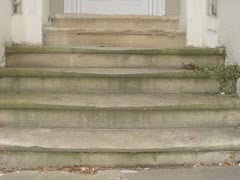The time of tests : Abrasion resistance
Led by Europe, more tests are being devised all the time to try to evaluate stone. In this column Barry Hunt explains the tests and discusses what the results show… and what they don’t. This time he looks at the abrasion resistance test.
The abrasion resistance test attempts to determine the level to which pedestrian trafficking may be resisted by assessing not just how hard a stone is, but how well the constituent minerals are locked together. These two factors together are important when you consider the example of a stone containing very hard grains that are poorly cemented so can be easily plucked out.
The problem with trying to assess pedestrian foot trafficking is that it is difficult to simulate. Even if it could be simulated the testing would be extremely time consuming. Therefore most abrasion tests are essentially based on a set amount of abrasive effort being applied to a stone and assessing its effects.
In Europe, the standard for the test is EN 14157 and involves the selection of one of three different methods of test. They are known as the (a) wide-wheel or Capon, (b) Bohme and (c) Amsler abrasion tests.
In the UK, the wide-wheel test is most commonly carried out. It is believed there is a correlation between these tests and the standard includes equations to convert values.
The wide-wheel abrasion test involves pushing a rotating wheel on to which an abrasive grit is fed against the test stone.
This is carried out for a set amount of time under a set loading and a set flow rate of the abrasive.
At the end of the test the length of the groove that has been cut is measured to give the abrasion resistance value.
Softer materials will be cut into more easily than others and thus the groove will be longer. The more abrasion resistant a stone is, the shorter the cut and the lower the value obtained.
The Bohme and Amsler methods both involve the abrasion of a whole face of a test sample under different loading and grit application conditions. The volume (in the case of Bohme) or thickness (for Amsler) of material removed is then determined.
These tests are closely related to the American abrasion resistance test, ASTM C241, which also takes the density into account to calculate a hardness value.
The American standards for dimension stone provide a number of minimum limits required for different types of stone to be considered acceptable. In Europe there are no such limits and the values just have to be declared when required.
In the UK, the Building Research Establishment (BRE) proposed some guidance on the results of the wide-wheel abrasion test in their Information Paper IP 10/00.
Starting with a calculation of the number of expected journeys in intensive, medium and low pedestrian traffic areas, it assigned limits for the wide-wheel abrasion test of <23 for intensive use such as shopping malls, 23-30 for office buildings and >30 for domestic use.
However, the guidance does not take into account the required service life of the surface nor the cleaning and maintenance regime. It also was not able to take into account channelled pedestrian flow such as through barriers and up and down stairs compared with more open areas.
Part 12 of BS 7533 deals with the use of natural stone for pavements on a bound base and includes maximum limits for abrasion resistance. There are two classes: 1 and 2, with 2 being for higher all round performance. Igneous rock types (eg basalt and granite) need to exhibit maximum values of 18mm and 12mm, and sedimentary rock types (eg sandstone and limestone) 28mm and 22mm for Class 1 and Class 2, respectively.
The test is difficult to set up and carry out and requires calibration every time it is run. Nevertheless, the results generally appear to be reasonably consistent and predictable for many stone types.
If there is a range in the individual test results of 20% or more it is worth asking for the test to be repeated.
One of the most useful aspects of this test is that it appears to be very good at picking out igneous rock types that have been weathered to a degree that may not be immediately apparent.
The test is also harsher on those rock types that contain more feldspar and less quartz, feldspar being a softer mineral and more susceptible to alteration.

